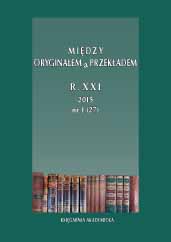Litera jako nośnik kultury (o trudnościach z tłumaczeniem cyrylicy)
Letter as a Carrier of Culture (on Problems with Cyrillic Translation)
Author(s): Magdalena OchniakSubject(s): Language and Literature Studies
Published by: KSIĘGARNIA AKADEMICKA Sp. z o.o.
Keywords: translation; changes in translation; Cyrillic; Russian literature
Summary/Abstract: It may seem that a letter, being a graphic sign, should not be an element causing difficulties in the process of translation. For every graphic sign appearing in a given alphabet, there are long-established patterns of transliteration, and for every sound, there are patterns of transcription allowing one to render its form in another language. However, it seems that this elementary unit of the alphabet begins to cause problems in translation from Russian into Polish, when words are combined to form collocations; it disappears from the alphabet at different stages of the historical development of a language, being retained, however, in older editions of texts that are still present and translated within a culture; it becomes an element of language games; the graphic form is of crucial importance for a given work and it is the key to understanding it. In situations of this kind, a translator’s task does not consist in a mechanical process of finding the graphic equivalents of letters among the set of letters (formal translation) but in providing a translation which adapts the original text to the target culture (functional translation). This article presents methods of translation which attempt to adapt the original text to the linguistic standards and to the culture of the target language, as exemplified by Russian authors of the nineteenth and twentieth centuries such as Leskov, Gorki, Tsvetaeva, Bulgakov and others.
Journal: Między Oryginałem a Przekładem
- Issue Year: 2015
- Issue No: 27
- Page Range: 9-24
- Page Count: 16

